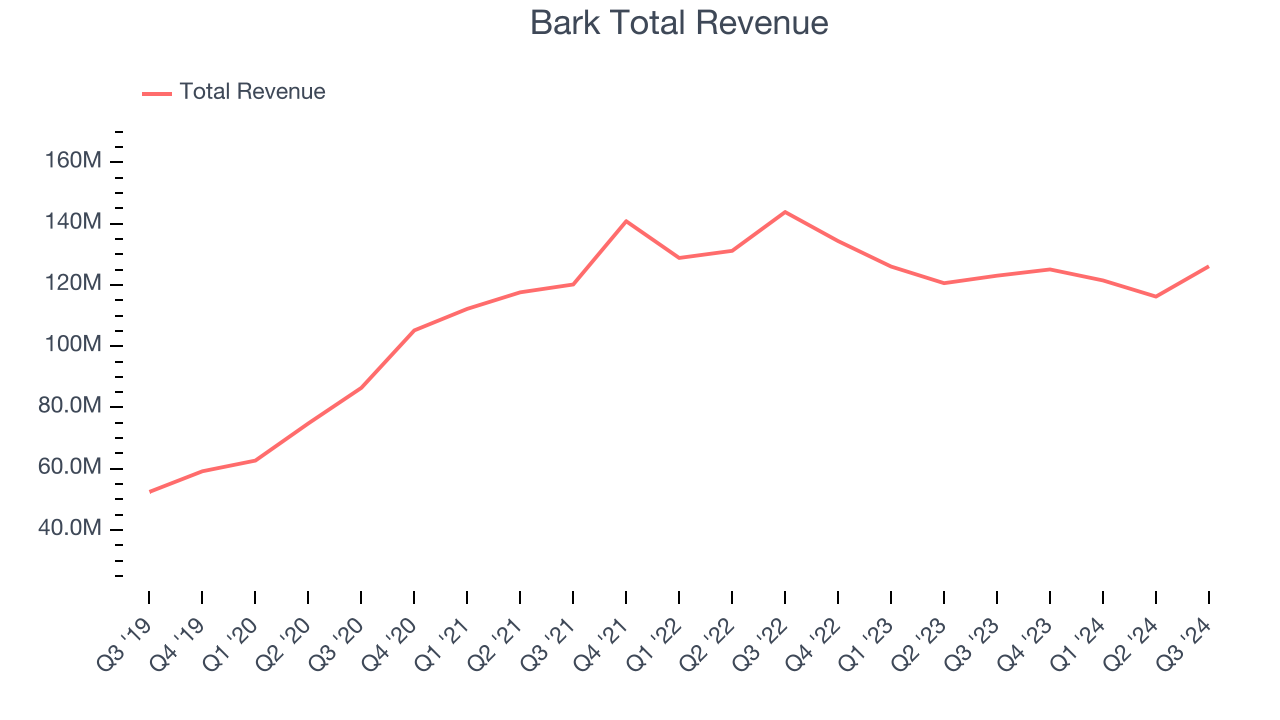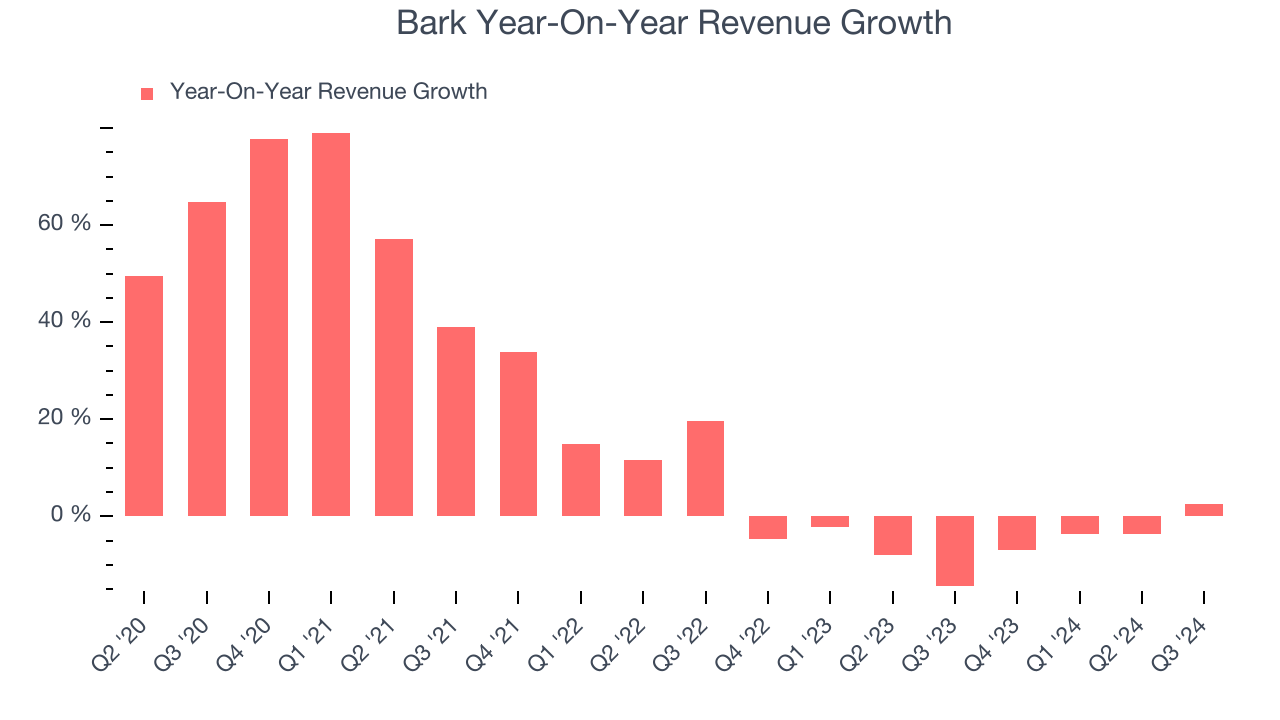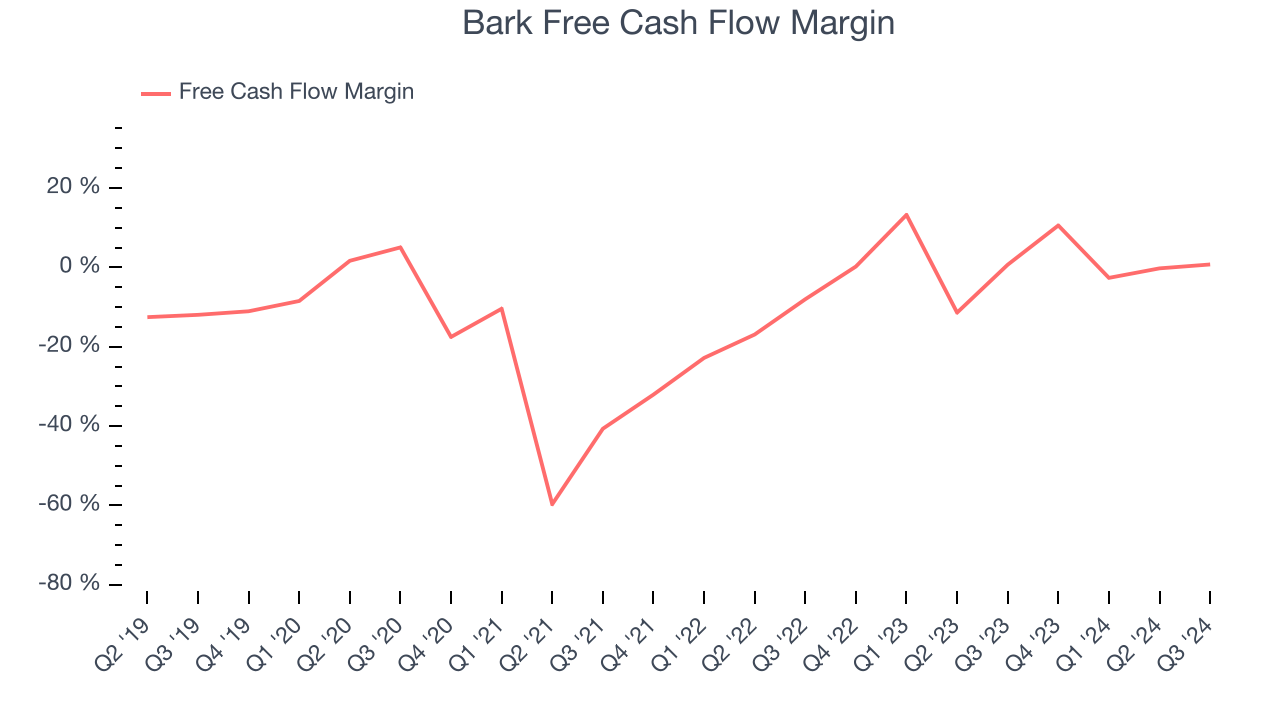
Pet products provider Bark (NYSE:BARK) met Wall Street’s revenue expectations in Q3 CY2024, with sales up 2.5% year on year to $126.1 million. On the other hand, next quarter’s revenue guidance of $124.5 million was less impressive, coming in 3.4% below analysts’ estimates. Its non-GAAP profit of $0.01 per share was 2,100% above analysts’ consensus estimates.
Is now the time to buy Bark? Find out by accessing our full research report, it’s free.
Bark (BARK) Q3 CY2024 Highlights:
- Revenue: $126.1 million vs analyst estimates of $125.2 million (in line)
- Adjusted EPS: $0.01 vs analyst estimates of $0 ($0.01 beat)
- EBITDA: $3.49 million vs analyst estimates of $1.88 million ($1.6 million beat)
- The company reconfirmed its revenue guidance for the full year of $495 million at the midpoint
- EBITDA guidance for the full year is $3 million at the midpoint, above analyst estimates of $2.86 million
- Gross Margin (GAAP): 60.4%, down from 61.5% in the same quarter last year
- Operating Margin: -4.5%, up from -9% in the same quarter last year
- EBITDA Margin: 2.8%, up from 0.8% in the same quarter last year
- Free Cash Flow Margin: 0.8%, similar to the same quarter last year
- Market Capitalization: $262.1 million
"We delivered our ninth consecutive quarter of year-over-year Adjusted EBITDA growth last quarter, driven in part by a 26% increase in our commerce segment revenue, compared to last year," said Matt Meeker, Chief Executive Officer of BARK.
Company Overview
Making a name for itself with the BarkBox, Bark (NYSE:BARK) specializes in subscription-based, personalized pet products.
Toys and Electronics
The toys and electronics industry presents both opportunities and challenges for investors. Established companies often enjoy strong brand recognition and customer loyalty while smaller players can carve out a niche if they develop a viral, hit new product. The downside, however, is that success can be short-lived because the industry is very competitive: the barriers to entry for developing a new toy are low, which can lead to pricing pressures and reduced profit margins, and the rapid pace of technological advancements necessitates continuous product updates, increasing research and development costs, and shortening product life cycles for electronics companies. Furthermore, these players must navigate various regulatory requirements, especially regarding product safety, which can pose operational challenges and potential legal risks.
Sales Growth
Examining a company’s long-term performance can provide clues about its business quality. Any business can put up a good quarter or two, but the best consistently grow over the long haul. Thankfully, Bark’s 18.8% annualized revenue growth over the last five years was solid. This is a useful starting point for our analysis.

Long-term growth is the most important, but within consumer discretionary, product cycles are short and revenue can be hit-driven due to rapidly changing trends and consumer preferences. Bark’s recent history marks a sharp pivot from its five-year trend as its revenue has shown annualized declines of 5.3% over the last two years. 
This quarter, Bark grew its revenue by 2.5% year on year, and its $126.1 million of revenue was in line with Wall Street’s estimates. Management is currently guiding for flat sales next quarter.
Looking further ahead, sell-side analysts expect revenue to grow 3.9% over the next 12 months, an improvement versus the last two years. While this projection shows the market thinks its newer products and services will fuel better performance, it is still below the sector average.
Unless you’ve been living under a rock, it should be obvious by now that generative AI is going to have a huge impact on how large corporations do business. While Nvidia and AMD are trading close to all-time highs, we prefer a lesser-known (but still profitable) semiconductor stock benefitting from the rise of AI. Click here to access our free report on our favorite semiconductor growth story.
Cash Is King
If you’ve followed StockStory for a while, you know we emphasize free cash flow. Why, you ask? We believe that in the end, cash is king, and you can’t use accounting profits to pay the bills.
Bark has shown poor cash profitability over the last two years, giving the company limited opportunities to return capital to shareholders. Its free cash flow margin averaged 1.5%, lousy for a consumer discretionary business.

Bark broke even from a free cash flow perspective in Q3. This cash profitability was in line with the comparable period last year and its two-year average.
Key Takeaways from Bark’s Q3 Results
We were impressed by how significantly Bark blew past analysts’ EPS expectations this quarter. We were also excited its EBITDA outperformed Wall Street’s estimates. On the other hand, its EBITDA forecast for next quarter missed and its revenue guidance for next quarter came in slightly below Wall Street’s estimates. Zooming out, we think this was a decent quarter featuring some areas of strength but also some blemishes. The stock traded up 3.4% to $1.53 immediately after reporting.
Big picture, is Bark a buy here and now? We think that the latest quarter is only one piece of the longer-term business quality puzzle. Quality, when combined with valuation, can help determine if the stock is a buy. We cover that in our actionable full research report which you can read here, it’s free.












